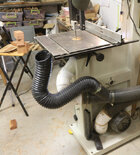Bought it used. Has worked fine until today. Was cutting a piece of Osage orange and it died. Circuit flipped also, 220. Reset that and lathe worked but bandsaw still did not. Opened up motor to see if there was a fuse—just a capacitor—and out of stock with Rikon. Will call tomorrow. Similar problems on a thread on Sawmillcreek.
Thoughts?
Thoughts?



